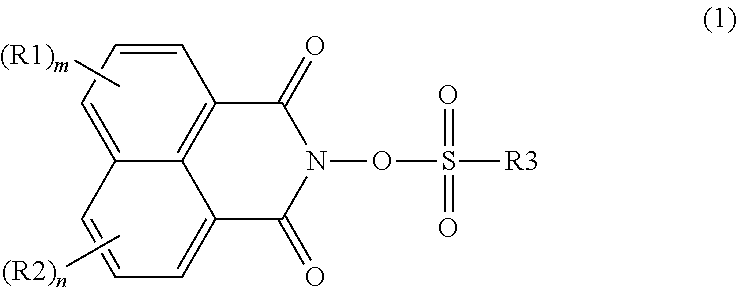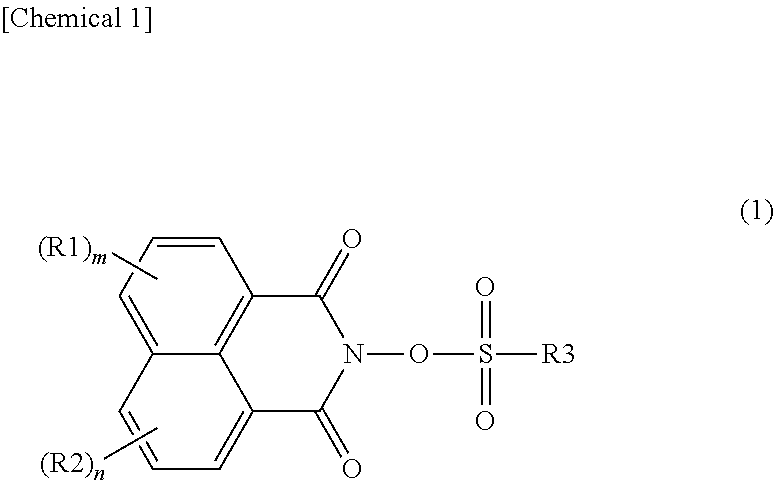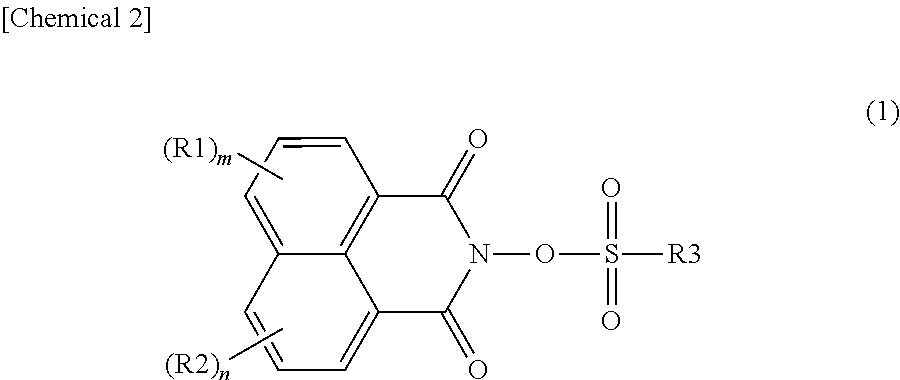Photoacid generator, and resin composition for photolithography
a photolithography and generator technology, applied in the field of photolithography resin composition and photolithography generator, can solve the problems of narrow allowance range, insufficient sensitivity to i-line, and insufficient resist performance, and achieve high molar absorption to i-line, easy decomposition, and excellent compatibility with hydrophobic materials.
- Summary
- Abstract
- Description
- Claims
- Application Information
AI Technical Summary
Benefits of technology
Problems solved by technology
Method used
Image
Examples
production example 1
Synthesis of N-(n-propyl)-4-chloro-1,8-naphthalimide [Intermediate (1)]
[0152]In DMF (100 mL), 4-chloro-1,8-naphthalic anhydride (23.3 g, 100 mmol) was dissolved, and to this, n-propylamine (5.6 g, 110 mmol) and pyridine (0.1 g, 1 mmol) were added to allow the contents to undergo a reaction for 3 hours at 90° C. Then, the reaction liquid was added in small portions to stirred water (500 mL) contained in a beaker, after which the precipitated yellow solid matter was filtered and washed with water to obtain 20.5 g of the title compound [Intermediate (1)]. The product was identified by 1H-NMR. {1H-NMR: 300 MHz, DMSO-d6, δ(ppm): 8.5 (m, 2H), 8.4 (d, 1H), 7.9 (m, 2H), 4.0 (t, 2H), 1.6 (m, 2H), 0.9 (t, 3H)}
production example 2
Synthesis of 4-isopropoxy-1,8-naphthalic anhydride [Intermediate (2)]
[0153]In isopropyl alcohol (100 mL), Intermediate (1) (1.2 g, 4.3 mmol) obtained in Production Example 1 was dissolved, and to this solution, sodium hydride (10 g, 43 mmol) was added in small portions to allow the contents to undergo a reaction for 15 hours at 80° C. To this, water (100 mL) and potassium hydroxide (30 g) were added to further allow the contents to undergo a reaction for 10 hours at 60° C. This reaction liquid was cooled to room temperature (25° C.), the reaction liquid was added in small portions to stirred water (500 mL) contained in a beaker, furthermore, hydrochloric acid was added thereto until the liquid becomes acidic, and the precipitated dark reddish-purple solid matter was filtered. This dark reddish-purple solid matter was recrystallized from isobutanol to obtain the title compound [Intermediate (2)]. The product was identified by 1H-NMR. {1H-NMR: 300 MHz, DMSO-d6, δ(ppm) 8.6-8.4 (m, 3H),...
production example 3
Synthesis of 4-n-propoxy-1,8-naphthalic anhydride [Intermediate (3)]
[0154]The title compound [Intermediate (3)] was obtained in the same manner as that in Production Example 2 except that the isopropyl alcohol (100 mL) was changed to n-propyl alcohol (100 mL). The product was identified by 1H-NMR. {1H-NMR: 300 MHz, DMSO-d6, δ(ppm) 8.6-8.4 (m, 3H), 7.8 (t, 1H), 7.3 (d, 1H), 3.7 (t, 2H), 1.6 (m, 2H), 0.9 (t, 3H)}
PUM
| Property | Measurement | Unit |
|---|---|---|
| wavelength | aaaaa | aaaaa |
| absorption wavelength | aaaaa | aaaaa |
| mole ratio | aaaaa | aaaaa |
Abstract
Description
Claims
Application Information
 Login to View More
Login to View More - R&D
- Intellectual Property
- Life Sciences
- Materials
- Tech Scout
- Unparalleled Data Quality
- Higher Quality Content
- 60% Fewer Hallucinations
Browse by: Latest US Patents, China's latest patents, Technical Efficacy Thesaurus, Application Domain, Technology Topic, Popular Technical Reports.
© 2025 PatSnap. All rights reserved.Legal|Privacy policy|Modern Slavery Act Transparency Statement|Sitemap|About US| Contact US: help@patsnap.com



